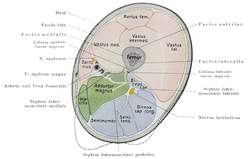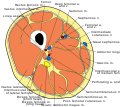This article needs additional citations for verification .(April 2011) |
| Thigh | |
|---|---|
 A woman's thighs | |
 Cross-section of the thigh showing muscles and bone (latin terminology) | |
| Details | |
| Identifiers | |
| Latin | femur |
| MeSH | D013848 |
| TA98 | A01.1.00.035 |
| TA2 | 160 |
| FMA | 24967 |
| Anatomical terminology | |
In anatomy, the thigh is the area between the hip (pelvis) and the knee. Anatomically, it is part of the lower limb. [1]
Contents
- Structure
- Bones
- Muscular compartments
- Blood supply
- Clinical significance
- Society and culture
- Additional images
- References
The single bone in the thigh is called the femur. This bone is very thick and strong (due to the high proportion of bone tissue), and forms a ball and socket joint at the hip, and a modified hinge joint at the knee. [2]




